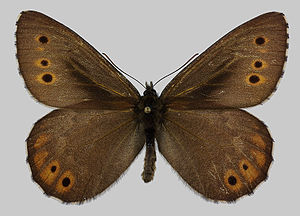Oeneis jutta
| Oeneis jutta | ||||||||||||
|---|---|---|---|---|---|---|---|---|---|---|---|---|

Oeneis jutta |
||||||||||||
| Systematics | ||||||||||||
|
||||||||||||
| Scientific name | ||||||||||||
| Oeneis jutta | ||||||||||||
| ( Huebner , 1806) |
Oeneis jutta , sometimes also called the Baltic velvet butterfly , is a butterfly (day butterfly ) fromthe noble butterfly family (Nymphalidae).
features
butterfly
The wingspan of the moth is 48 to 60 millimeters. Fore and hind wings have a light brown to reddish brown color on the upper side. Two to three black eye spots stand out in the submarginal region of the upper fore wing. The top of the hind wings is marked with one or two black eye spots near the anal corner. All eye spots have a more or less orange border, which makes it easy to distinguish the moths from other Oeneis species. The undersides of the forewings are yellow-brown, the upper side ocular spots shine through. The hind wing underside is marbled black-gray to black-brown.
egg
The spherical eggs are initially green-yellow and soon turn brownish tones. On the entire surface there is a striped pattern made up of many whitish, strongly jagged longitudinal lines.
Caterpillar
Adult caterpillars are brownish, ocher or greenish in color and provided with reddish brown side lines and stripes. The body has very short brown hairs and weakly forked at the end.
Doll
The yellowish pupa shows many brown spots and heavily darkened wing sheaths.
Distribution and occurrence
The species occurs in the northern regions of Europe, Asia and North America. Oeneis jutta prefers to colonize grassy wetlands, swamps, pine forest edges and tundras .
Subspecies
The following subspecies are distinguished:
- Oeneis jutta jutta (Hübner, 1806) in Fennoscandinavia , the Baltic States , the Urals , Siberia , the Yenisei and Amur regions , on Sakhalin as well as in the north of China , Korea and Mongolia
- Oeneis jutta akoene Belik & Yakovlev, 1998 Altai Mountains and in Tuva
- Oeneis jutta alaskensis Holland, 1900 in Alaska , Yukon and northern British Columbia
- Oeneis jutta ascerta Masters & Sorenson, born 1968 in southeast Manitoba , in Ontario , Québec , Minnesota , Wisconsin , Maine and New Hampshire
- Oeneis jutta balderi (Geyer, 1837) on Newfoundland
- Oeneis jutta chermocki Wyatt, born in Alberta and southern British Columbia in 1965
- Oeneis jutta harperi Chermock, 1969 in northern Manitoba and in the east of the Northwest Territories
- Oeneis jutta leussleri Bryant, 1935 in the west of the Northwest Territories
- Oeneis jutta reducta McDunnough, 1929 in Montana , Wyoming , Utah and Colorado
- Oeneis jutta ridingiana F. & R. Chermock, 1940 in southwest Manitoba and Saskatchewan
- Oeneis jutta sibirica Kurentzov, 1970 in Yakutia and Magadan
Way of life
The moths fly in one generation from May to August, depending on the region. Occasionally they suck nectar from flowers. They like to rest on tree trunks with their wings folded together, making them difficult for predators to see. Various sourgrass plants (Cyperaceae), for example Eriophorum spissum , Carex geyeri and Carex concinna, are named as food plants for the caterpillars . Since the species occurs predominantly in areas with only short warm periods and nutrient-poor vegetation, it takes two years to develop. The caterpillars overwinter first in the first, second or third and for the second time in the fourth, fifth or sixth instar.
supporting documents
Individual evidence
- ↑ a b Tom Tolman, Richard Lewington: The butterflies of Europe and Northwest Africa . Franckh-Kosmos Verlag, Stuttgart 1998, ISBN 3-440-07573-7 .
- ^ Butterflies and Moths of North America http://www.butterfliesandmoths.org/species/Oeneis-jutta
- ^ Stages of development in "Butterflies of America" http://www.butterfliesofamerica.com/oeneis_jutta_reducta_immatures.htm
- ↑ a b c James A. Scott: The Butterflies of North America: A Natural History and Field Guide. Stanford University Press, Stanford, California 1986, ISBN 0-8047-2013-4 , pp. 250/251.
- ↑ Distribution and subspecies
- ↑ Vladimir Lukhtanov, Ulf Eitschberger: The Butterflies of the World: Nymphalidae V, Oeneis. Verlag Goecke & Evers, 2000, ISBN 3-931374-80-7 .
- ↑ Typical behavior and habitat http://www.kolumbus.fi/esko.viitanen/ojutta_e.htm
literature
- Tom Tolman, Richard Lewington: The butterflies of Europe and Northwest Africa . Franckh-Kosmos Verlag, Stuttgart 1998, ISBN 3-440-07573-7 .
- James A. Scott: The Butterflies of North America: A Natural History and Field Guide. Stanford University Press, Stanford, California 1986, ISBN 0-8047-2013-4 , pp. 250/251
Web links
- Lepiforum e. V. - Taxonomy and photos
- Oeneis jutta near Fauna Europaea. Retrieved October 23, 2013